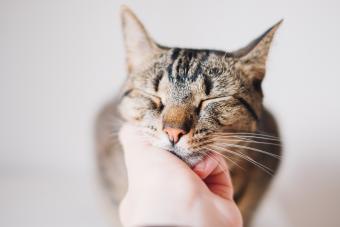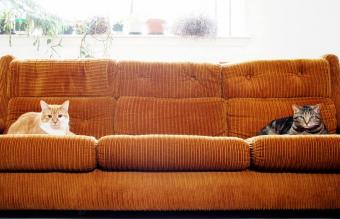
Everyone knows that cats and water don't mix. Even so, scientists still don't have a straightforward answer to the question of why domesticated cats hate water. There are several theories around the idea, though, like the fact that domestic cats originated in desert environments where bodies of water were scarce, or that a coat full of water can weigh these predators down. Discover more about why most cats have this aversion and how you can train your cat not to hate water quite so much.
Why Do Cats Really Hate Water?
Your cat might gladly drink from a dripping faucet all day but wouldn't even dream of stepping foot into a bath full of water. What gives? It's not so much that cats hate water; it's more so that they hate being wet. Experts don't know exactly why cats have such a strong aversion to H2O, but there are several theories; some involve evolutionary adaptations, and others imply cats' dislike for water is more of a learned trait.
1. Cats Originated in Low Water Environments
Domesticated house cats we know them today are descendants of wild cats from northern Africa and the Middle East. These desert-dwelling felines didn't have frequent access to large bodies of water, so they just never became accustomed to them. This is a big contrast to the large jungle cats, like tigers, who enjoy playing in the water.
Cats have instinctually learned to steer clear of standing water - which is more likely to contain parasites - and some prefer to only drink running water.
2. Water Weighs Them Down
Animals that are designed for the water usually have slick, water-resistant fur, and even though your cat's coat might be shiny, it's not water-proof. Water soaks right through a cat's soft fur all the way to their skin. This absorption can weigh a cat down and make them slower, which can have dire consequences in the wild. For your house cat, they may just not like the feeling of being soaked.
3. Water Lowers Their Core Temperature
A cat's normal temperature is a toasty 100 to 102.5 degrees Fahrenheit, and it's no secret these furry creatures love being warm. Being covered in water can cause their core body temperature to drop significantly, which can be uncomfortable or even dangerous for a cat, which might be why they hate it.
4. Water Can Alter a Cat's Personal Scent
Cats use scent as a form of communication. They rub the scent glands found in the base of their tail, cheeks, forehead, and paws to mark objects or members of their colony. Water can rinse these important pheromones off a cat's skin.

5. Water Can Be New and Scary
Many cats just aren't trained to tolerate water the same way other pets are. Puppies will experience a bath within the first few weeks of coming home, and bath time is a regular occurrence for most dogs to keep their skin and coat free of debris. But owners rarely bathe their cats because cats are constantly bathing themselves.
The average cat spends 30 to 50 percent of their day licking and grooming themselves. That's a lot of bath time!
Cat Breeds Known to Love Water
Not all cats hate water. There are several breeds that actually really like getting wet. For example, the Turkish Van is nicknamed "the swimming cat" because this breed absolutely adores the wet stuff. Other water-loving cat breeds include:
- Bengal
- Maine Coon
- Turkish Van
- Sphynx
- Savannah
- Abyssinian
Training a Cat to Like Water
If you have a breed that will need regular baths, such as a Sphynx, or you just want your pet to grow up without fear of water, you can train your cat to tolerate water. It's best to start the process as early as possible because kittens are more accepting of new experiences.
- Make the bathtub or sink a "fun zone." Create a positive experience in the area where you'll expose your cat to water. Play with them there, give them lots of pets, and offer them their favorite treats so they feel comfortable. Repeat this several days in a row.
- Rub them with a warm, damp cloth. Get your cat used to the sensation of being wet by rubbing them with a warm, damp cloth. The idea is to just get their fur damp, not drench them entirely. Start by touching their feet, legs, and tail with the cloth so they can smell and investigate the water. Do this as part of one of your play sessions, and be sure to reward them generously afterward. Repeat daily until your cat doesn't react to the water.
- Let them dip their toes in. After getting them used to being damp, you can allow your cat to explore the water. Place a towel in the bottom of the tub or sink and let a small amount of warm water collect so only about ⅓ of the tub is wet and the other portion is dry. Play with and pet your cat and naturally guide them toward the water until they step into it on their own. Don't force your cat into the water if they are fearful or not ready. Repeat this until your cat is comfortable getting their feet wet.
- Continuously add water. With a towel on the bottom of the tub for traction, repeat this daily play and water session with your cat while increasing the amount of water in the tub as they grow more comfortable. Never leave your cat unsupervised in the water or fill the tub higher than a few inches; this should be plenty for bathing your cat.
Create a Positive Experience Around Water
Not only is it interesting to learn why your cat exhibits certain behaviors, but it can be really helpful, too. Understanding the origin of these fears can allow you to accept that your cat just isn't a fan of something, or slowly expose them to these things while creating a positive experience around it. If your cat is one who absolutely despises water, it's possible to take that dislike, and turn it into tolerance or even enjoyment. With time, your cat will learn they won't melt anytime water touches them.







